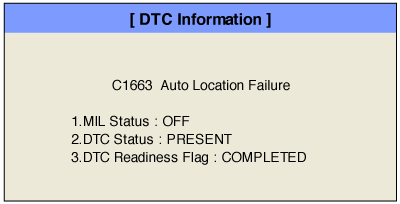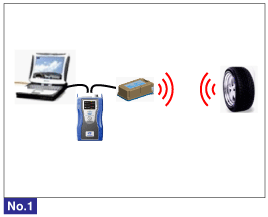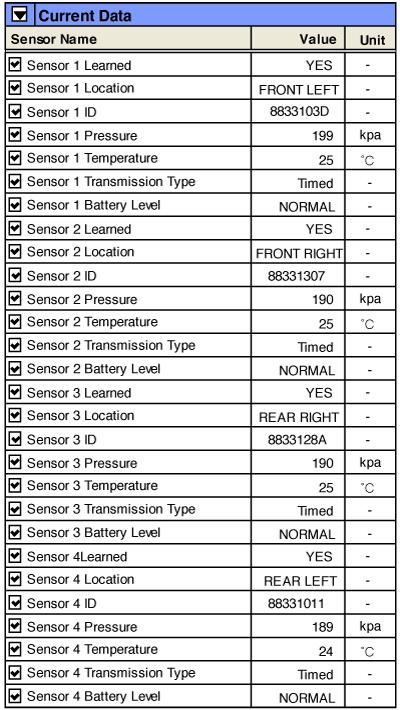If there is any DTC besides C1663, firstly check the DTC and repair sensors and then confirm the recurrence of C1663 DTC.

- History (Not Present) fault : DTC occurred but has been cleared.
- Present fault : DTC is occurring at present time.
Vehicle Parked & Ignition ON.
Connect GDS and select "DTC Analysis" mode.
Click "DTC Status" on the "Diagnostic Trouble Codes(DTC)" menu bar to see DTC's information.
Confirm that "DTC Readiness Flag" indicates "COMPLETED". If not, drive the vehicle within conditions noted in the freeze frame data or enable conditions.
Read "DTC Status" parameter.
If there is any DTC besides C1663, firstly check the DTC and repair sensors and then confirm the recurrence of C1663 DTC.

- History (Not Present) fault : DTC occurred but has been cleared.
- Present fault : DTC is occurring at present time.
Is parameter displayed "Present fault"?
 | ▶ Go to Next procedure. |
 | ▶ This fault was repaired and TPMS ECU memory was not cleared. Go to "Verification of Vehicle Repair" procedure. |
Connect GDS and select "Diagnostic Trouble Codes(DTC)" mode.
After driving at 25 km/h for approx. 10~20 minutes.
Check that current data is correctly displayed while driving.
Measuring method : Refer to No.1 Measurement


No.1) A method of checking a sensor ID with VCI
Current data is normally displayed?
 | ▶ Fault is intermittently caused or was repaired and TPMS ECU memory was not cleared. ▶ Go to "Verification of Vehicle Repair" procedure. |
 | ▶ Besides C1663 , check the internal/external factors which could interfere with DTC, sensor status, and radio signal(RF) in the vehicle. ▶ Substitute with a known-good TPMS ECU and check for proper operation. If problem is corrected, replace TPMS ECU and then go to "Verification of Vehicle Repair" procedure. ▶ After replacing with a known-good TPMS ECU(or TPMS Receiver), you must do the 'Vehicle Name Writing', 'VIN Writing' and 'Register Sensor' at the "Vehicle S/W Management" mode by using GDS and GDS TPMS. |